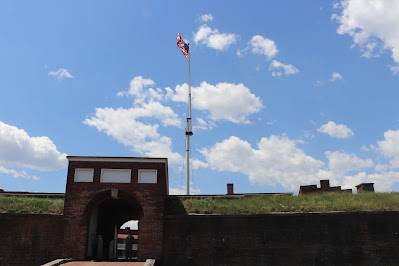 |
| Diagram of the Battle |
We woke up to our first day in almost a week without the
threat of rain. (Last night there was 2” hail just west of us.) We also have
done 3 days straight of museums, so instead of going to the National Aquarium
in Baltimore, we decided to go to Fort
McHenry. After watching the park movie, we listened to the ranger talk on
the Battle for the Chesapeake during the War of 1812. He used red cones to
represent the British Fleet or their 5000-man army and blue cones to represent
American privateers and militia. The British were fighting the French in the
Napoleonic Wars, but this had affected U.S. trade, since the British would sink
any ship trading with France, and they often stopped American ships to search
for “British deserters” impounding them to serve in the British Navy. After
much debate, the U.S. declared war on Britain to begin the War of 1812. Congress
sent the U.S. Army to Canada, intent on extending the U.S. borders North. They
burnt down the city of Toronto as part of that attempt.
In 1814, the war with Napoleon ended, so Britain sent their fleet and army to the U.S. targeting the population centers and agriculture of the resource-rich Chesapeake Bay. With the army near Canada and no real Navy, only local militia and privateers were available to defend the Bay. The British declared that any town that shot at the British would be burned down. Indeed, they burned several towns. While the privateers had some success against the British Navy, they were eventually cornered up-river and burned their ships to avoid capture by the British. Then the British targeted Washington, D.C. When the 5000-man British army encountered the 7500 militia defending D.C., the ill-trained militia ran, and the British came in and burned D.C. However, here they only burned the government buildings, leaving homes alone. Their next target was Baltimore, the 3rd largest city in America and the largest port. The army first tried attacking the city from the East, but the Americans had a large militia who were dug in East of the city with substantial earth works on a hill above the city. The British concluded that they couldn’t take the city that way, so the plan was to attack the city by sea. Meanwhile, Francis Scott Key was sent to the fleet under a white flag to negotiate the release of a U.S. Citizen who had been taken as a prisoner of war in Washington. He completed the negotiation but wasn’t allowed to return to Baltimore until after the battle. The American forces had sunk ships along the channel that led to the Baltimore harbor and stretched a chain across the remaining portion. This would force any invading ships to be within gun range of Fort McHenry which was on a peninsula near the harbor entrance. The problem was that the guns and rockets of the British fleet could bombard the fort from two miles, while the cannon of the fort could only fire about 1 ½ miles. At 7 AM on September 13th, 1814, the British bombardment of the Fort began.
 |
| Defense Batteries |
Key
watched “The rockets red-glare, the bombs bursting in air” all day and night.
The bombardment lasted 24 hours, and through the smoke, Key searched to see
which flag was flying above the Fort. As we all know… he saw the Stars and
Stripes still flying. The British concluded that there was no way, they would
be able to destroy the Fort from the sea. They left the area, and the peace
treaty of Ghent was signed about 3 months later.
 |
| Star Spangled Banner above the Fort |

No comments:
Post a Comment